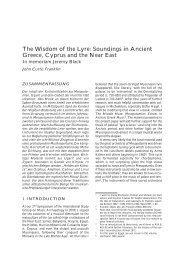KINYRAS AT PYLOS John C. Franklin University of Vermont Kinyras ...
KINYRAS AT PYLOS John C. Franklin University of Vermont Kinyras ...
KINYRAS AT PYLOS John C. Franklin University of Vermont Kinyras ...
You also want an ePaper? Increase the reach of your titles
YUMPU automatically turns print PDFs into web optimized ePapers that Google loves.
and exemplifies the opposite process, a god dwindling into mortality after losing his palatial<br />
home. 55<br />
Excursus: <strong>Kinyras</strong> and The Lyre-Player Seals<br />
The proverbial association <strong>of</strong> <strong>Kinyras</strong> with Cilicia was mentioned above. Cilicia now seems the<br />
most probable point <strong>of</strong> origin for the famous Lyre Player group <strong>of</strong> seals (second half <strong>of</strong> the<br />
eighth century), given the intersection <strong>of</strong> stylistic parallels and geographical distribution—<br />
notably a large number <strong>of</strong> new examples from the Adana museum. 56 The corpus is so-called<br />
from an important minority, roughly one quarter <strong>of</strong> the total, in which lyrists appear in a number<br />
<strong>of</strong> interesting variations, including one detailed ritual-banquet scene which seems to present the<br />
full picture <strong>of</strong> which the other relevant specimens seem to be ‘excerpts . . . or abbreviations’<br />
(though not ‘merely derivative’). 57 While the lyre-player is sometimes larger than other figures,<br />
55 Compare the goddess Ipemedeja, known from a Pylian <strong>of</strong>ferings tablet where she appears in company<br />
with Poseidon (PY Tn316 = DMG 2 172); she survives as Iphimedeia in Hom. Od. 11.305, the mother <strong>of</strong> Otus<br />
and Ephialtes by Poseidon, but enjoyed no cult status in historical times. See Gérard-Rousseau 1968, 116–8<br />
(noting entries for other vanished palatial gods like Dopota, Tiriseroe, Manasa, Dirimijo and Pere*82);<br />
DMG 2 288; Burkert 1985, 43.<br />
56 Lyre-player seals: Blinkenberg 1931, 161–7 and pl. 18.521–35 and J; Porada 1956 treated 54;<br />
Boardman/Buchner 1966 catalogued 162 (the Ischia find-contexts yield the securest dating for the group as a<br />
whole); Boardman 1990 added 25 (see also 1 n. 3 for further secondary references); Poncy, et al. 2001, 11 f.<br />
contributed a further 35, many from Cilicia; Borgia/Casabonne/Egetmeyer 2002, 177–81. Italian finds are<br />
from Ischia, Cumae, Etruria; Greek from Ithaca (Aetos), Thebes, Delphi, Sunium, Aegina, Corinth, Sparta,<br />
Lefkandi, Delos, Paros (the Delion), Crete, Chios, Samos, Rhodes (Lindos, Kameiros); Cypriote from Ajia<br />
Irini; Near Eastern from Kultepe, Carchemish, Zinjirli, Aintab (Gaziantep), Tarsus, Al Mina, Byblos, Tell<br />
Basher, Megiddo. At least 49 more are still unpublished, including unprovenanced Syrian/Levantine<br />
examples. Parallels <strong>of</strong> dress: Karatepe; servants and lord/god <strong>of</strong> same size: Zincirli, Karatepe, Tell Halaf,<br />
Carcemish; the banquet motif is general in the Near East: Boardman/Buchner 1966, 44, 48 f. Poncy, et al.<br />
2001, 11 look to the prosperous reign <strong>of</strong> Urikki, king <strong>of</strong> Que. This would not conflict with the Assyrian<br />
elements seen by Boardman 1990, since Que seems to have been a tributary state for most <strong>of</strong> the eighth<br />
century, before becoming a province in the seventh (Hawkins 2000, 1.41–4; CAH 2 III.2 86, 90).<br />
57 No. 167 in Boardman 1990, 8 and fig. 16.






